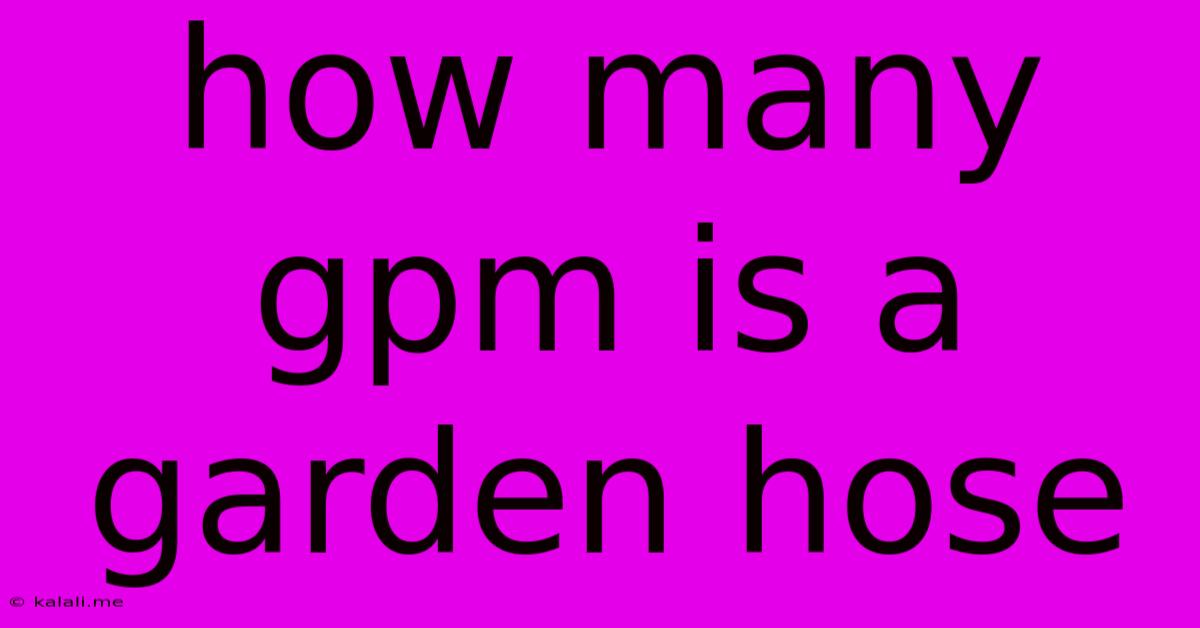How Many Gpm Is A Garden Hose
Kalali
May 30, 2025 · 3 min read

Table of Contents
How Many GPM is a Garden Hose? Understanding Your Watering Power
So, you're ready to tackle that thirsty lawn or give your flowerbeds a much-needed drink, but you're wondering: how much water is actually coming out of your garden hose? The answer isn't a simple number, as the gallons per minute (GPM) flow rate of a garden hose depends on several factors. This article will break down the influencing factors and give you a better understanding of your hose's watering capabilities.
What Factors Determine Garden Hose GPM?
The flow rate of your garden hose isn't solely determined by the hose itself. Several interconnected elements influence the final GPM:
-
Water Pressure: This is arguably the biggest factor. Higher water pressure from your home's water supply directly translates to a higher GPM. Low water pressure, common in older homes or areas with high water demand, will significantly reduce the flow rate. You can check your water pressure with a simple gauge readily available at most hardware stores.
-
Hose Diameter: Thicker hoses (typically those with larger inner diameters, often expressed in inches) generally allow for higher flow rates than thinner hoses. A larger diameter provides less resistance to water flow, resulting in a stronger stream.
-
Nozzle Type and Setting: The nozzle you attach to your hose significantly impacts the GPM. A fully open nozzle will allow for the maximum flow rate, while restrictive nozzles (like those used for gentle watering) reduce the GPM. Different nozzle settings—from jet to shower—also change the flow.
-
Hose Length: Longer hoses often result in slightly lower GPM due to increased friction within the hose itself. The longer the hose, the more friction and resulting pressure drop.
-
Kinks and Blockages: Any bends or blockages in the hose will restrict water flow and decrease the GPM. A simple kink can drastically reduce the amount of water flowing through.
Average GPM for Garden Hoses:
While a precise GPM is difficult to state without knowing your specific water pressure and hose setup, here’s a general range:
-
Typical Garden Hose (with a fully open nozzle): You can expect a GPM ranging from 5 to 10 GPM. This is a broad range due to the variables listed above.
-
Hoses with High-Flow Nozzles: Some high-flow nozzles can increase the GPM, pushing the upper limit of this range.
-
Low-Flow Nozzles: These are designed for water conservation and typically output much less than 5 GPM.
How to Measure Your Hose's GPM:
Measuring your hose's GPM is straightforward:
-
Gather supplies: You’ll need a one-gallon container (a bucket or jug) and a stopwatch.
-
Prepare the hose: Attach the nozzle you intend to use. Ensure there are no kinks or blockages in the hose.
-
Collect the water: Turn the water on and use the stopwatch to time how long it takes to fill the one-gallon container completely.
-
Calculate GPM: Divide 60 (seconds in a minute) by the time (in seconds) it took to fill the container. For example, if it took 10 seconds to fill the container, your GPM is 60/10 = 6 GPM.
Understanding Your GPM for Efficient Watering:
Knowing your hose's GPM helps you plan your watering schedule more effectively. You can estimate how long it takes to water a specific area, and importantly, conserve water. If you're seeking to conserve resources, consider using a low-flow nozzle or a soaker hose for more efficient irrigation. Consider the needs of your plants and the soil's moisture level.
By understanding the factors affecting your garden hose's GPM and performing a simple measurement, you can maximize your watering efficiency and keep your plants thriving.
Latest Posts
Latest Posts
-
Proper Email Signature For Graduate Student
May 31, 2025
-
See Ya On The Flip Side
May 31, 2025
-
Database For Unlimited Rows Of Data
May 31, 2025
-
Where Is Solicitation A Prostitute Not A Crime
May 31, 2025
-
Whats The Ph Of Distilled Water
May 31, 2025
Related Post
Thank you for visiting our website which covers about How Many Gpm Is A Garden Hose . We hope the information provided has been useful to you. Feel free to contact us if you have any questions or need further assistance. See you next time and don't miss to bookmark.